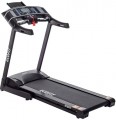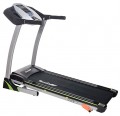Max. user weight
The highest weight of an athlete, at which the treadmill can work indefinitely for a long time (at least during the warranty period) without negative consequences. Most modern models have a "weight category" of the order of 150 kg and even more, which allows them to be used even by people of large build. However, there are exceptions, so this parameter is still worth paying attention to when choosing a treadmill.
It is worth choosing a model by weight with a significant margin — at least 10 kg more than your weight, even if you expect to lose it during training. If, on the contrary, you are going through a comprehensive training course to gain weight, then you should focus on the result you want by the end of the course. Anyway, the "weight category" of the machine must be greater than the weight of the user. Otherwise, the device will work with off-design loads and may break at any time.
If the treadmill is planned to be used for several users, you need to focus on the weight of the heaviest of them.
Min. running speed
The slowest speed at which the treadmill belt can move. This parameter is indicated only for
electric models (see "Load system"), as in other types, it depends solely on the user himself.
The ability to operate the belt at a low speed is important if strong loads are contraindicated — for example, during the rehabilitation period after injuries. In many modern models, this figure is only 1 km/h (even though the average walking speed of a healthy person is about 5 km/h). Thus, they can be used even with serious injuries, when normal walking is very difficult.
Max. running speed
The highest speed at which the treadmill belt can move. This parameter is indicated only for models of the electric type (see above). For mechanical and magnetic ones, it depends solely on the capabilities of the athlete himself, and it is impossible to accurately indicate the maximum speed in the characteristics of such machines.
The higher the maximum speed the greater the load can be given to the athlete and the better the treadmill is suitable for intensive training. However, for home models, a speed of 15 – 16 km/h is considered quite sufficient; "faster" machines usually belong to the advanced class and are designed for professional athletes.
Note, that for everyday use it does not always make sense to chase a high maximum speed. If your level of physical fitness is not high or if high loads are undesirable, a speed of 10 – 12 km/h may well be enough.
Motor power
Power of the motor installed in the electric treadmill (see "Load system"). This parameter is directly related, first of all, to the smoothness of the belt movement and the maximum speed (see above) — the more powerful the motor, the more uniform the movement of the belt will be and the faster it can move. Also, motor power determines the resistance to high loads: with an equal weight category (see "User weight"),
a more powerful model is better suited for people with large body weight, especially at high speeds.
In general, most recreational treadmills have motors between 1.5 and 2.5 hp; more powerful options usually belong to the professional class.
It is worth noting that above we were talking about the constant power of the motor — that is, the power with which it can work for a long time without being subjected to overloads. In some models of treadmills, the so-called peak power — the power that the motor can develop for a short time, for a few seconds. It is higher, but long-term operation at such a load is fraught with the failure of the device. Therefore, before buying, it is worthwhile to clarify, if possible, what power is implied in the specs — nominal or peak; this is especially true for high-power models.
Incline adjustment
Possibility to change the angle of inclination of the treadmill. Due to this, in mechanical and electrical models (see "Load system"), the load is regulated; in the first case, this is generally the only option for changing the load, and in the second, the slope of the belt allows you to simulate movement uphill (and in some models, vice versa, from the mountain).
The angle of inclination is usually adjusted manually by setting the belt to a certain level of a special stop. However, there are also automatic models where a separate drive does this, and the user only needs to give a command from the control panel. The second option is more convenient but significantly more expensive.
Max. incline angle
The largest angle at which the treadmill can be tilted; For details on this function, see "Adjustable incline". The greater the maximum angle, the steeper the climb can be simulated by the treadmill, and the more intense the load it can provide. The angle of inclination is calculated from the horizontal.
Some models allow you to tilt the belt not only simulating an ascent but also simulating a descent. For such models, two values of the maximum angles are indicated, while the “downhill” angle is indicated by a negative number — for example, “20 ° / -6 °”
Cushioning system
The cushioning system softens the shock felt when running on the treadmill and thus reduces stress on the bones and joints. Roughly speaking, due to this system, the belt “springs” under your feet, and the run turns out to be softer. This feature can be useful to any user, but it will be especially useful for those who are just starting, as well as for people with a large body weight.
Transport wheels
Special wheels or other similar devices provide additional convenience when moving the treadmill. Treadmills have a fairly significant weight — tens of kilograms — and carrying them in your hands is fraught with significant difficulties, and moving on the floor without additional devices is fraught with scratches on the coating. Wheels also allow you to roll the treadmill with a minimum of effort and without risking damage to the flooring.
Training programs
The number of
training programs provided for in the design of the simulator. This is not about load levels, but about automatic modes of operation, during which the belt can change the speed of movement, signal the beginning and end of a workout, etc. For details on the number of programs, see Programs and information.

